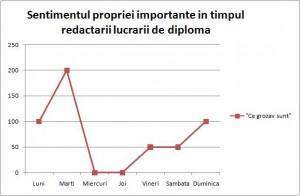După primul curs, am avut și primul student care a ținut morțiș să-și facă lucrarea de diplomă cu mine. Fiind el la sfârșitul celor 3 ani de început de facultate, n-aveam a-l tortura cu idei de cercetare, ci doar cu cele de programare, credea dânsul. Sigur că da, doar programare. Și redactarea unei lucrări. Și prezentarea ei. Și explicat oamenilor nu doar ceea ce ai făcut, ci și de ce ai făcut așa și nu altfel. Și limba engleză. Și uite așa timp de un semestru întreg, propria importanță a studentului cu pricina a luat-o razna, când în sus și când în jos. Cam ca în graficul alăturat. Ghiciți în ce zi a săptămânii venea să-mi arate ce a făcut?
Dar la final n-am văzut student mai încântat decât el de ceea ce a realizat. Și nici notă mai mare dată în aceeași sesiune de către comisie. Consider de altfel că nota e pe deplin meritată și am apreciat în mod deosebit efortul depus de student pentru a beneficia la maxim de ajutorul pe care i l-am oferit. De altfel după ce i-am desființat la antrenamente a doua versiune de prezentare și a plecat cu lista lungă de probleme și sugestii, nemaifiind timp să mai vină odată, a preferat să pună pe youtube și să-mi trimită link-ul ca să afle dacă e bine. Era mai bine, dar nu de ajuns. Prezentarea finala în fața comisiei a fost însă apreciată de toată comisia drept cea mai bună din toată sesiunea.
Totuși, pe obositorul parcurs al extirpării problemelor atât de banale încât n-ai fi crezut că trebuie să fie acolo vreodată, am realizat câteva lucruri care mă gândesc că pot servi și altora, în special studenților la calculatoare:
- Nu vorbiți cu oamenii cum vorbiți cu calculatorul! Poate părea evident, nu? Dar atunci de ce explicați în amănunte minuscule pașii banali ai lui CUM în loc să spuneți oamenilor întâi de toate CE anume vreți să faceți? Și de ce mai aveți nițel și faceți toată lucrarea în pseudo-cod?
- Programarea nu e o scuză ca să petreceți mai mult timp cu calculatorul. Uluitor, știu, dar nu, nu este câtuși de puțin. E doar o unealtă destul de evoluată care vă permite să faceți ceva util. Util adică de folos altor oameni. Deci nu, nu e acceptabil să nu aveți idee cui și în ce mod folosește programul făcut de voi. Și nu, nu e acceptabil să puneți utilizatorul să apese mai multe butoane pentru că așa e mai simplu de programat.
- Google e un motor de căutare, nu un Oracol. În consecință, nu e un argument valid faptul că primul răspuns pe Google a spus că... Nici al doilea. Nici al treilea și nici al 1000-lea.
- Se presupune că vă știți propria lucrare. De aceea, prezentarea ei nu e ca să demonstrați că o știți, ci ca să comunicați ce anume ați făcut și cât de bine.
- Cunoașterea unui limbaj de programare nu vă scutește de a vorbi coerent. Ba chiar în cazul dat, a vorbi coerent în limba engleză, chiar dacă nu e limba maternă. Se recomandă călduros o carte celebră de altfel, The Elements of Style.
Acestea fiind spuse, puteți vedea rezultatul final aici și o versiune intermediară a prezentării pe youtube (partea1 și partea2). Pentru cei care urmează să-și prezinte propria lucrare: care sunt principalele probleme pe care le vedeți la prezentare?